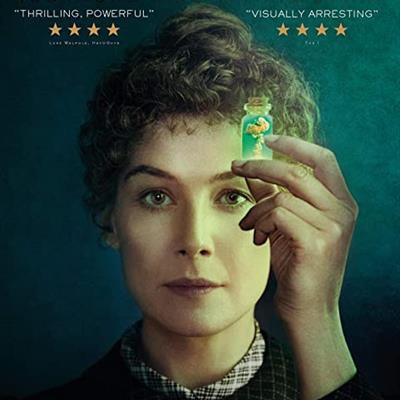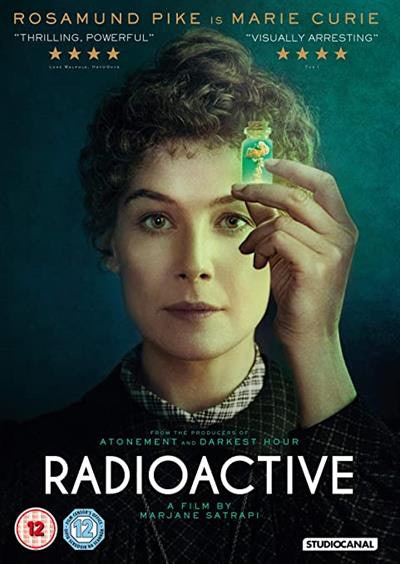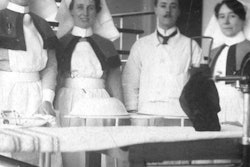
Maria Skłodowska-Curie is one of those rare individuals about whom there is always more to say. Her work and personality are now the subject of a new movie, "Radioactive," which is directed by Marjane Satrapi, the Iranian-born French author and illustrator.
There have been innumerable books, plays, films, and even comic books about Marie Curie. More recently, the Polish composer Elżbieta Sikora, who like Marie is a resident in France, wrote an opera titled "Madame Curie" (2011) and sees Marie's life story as a truly operatic libretto, needing little in the way of embellishment. Sikora did not want Marie Curie to be a personality that we know from textbooks -- the figure of a scientist who worked day and night on her discoveries -- but rather to be shown as a human being "who also walked this earth, who had her own intense emotional and intellectual life in all of its forms." This sentiment is also apparent in this new movie.

Rosamund Pike, a well-known U.K. actor, plays the role of Marie Curie, while Sam Riley, also a U.K. actor, is her husband and scientific collaborator Pierre Curie. The film is based on the graphic novel "Radioactive: Marie & Pierre Curie: A Tale of Love and Fallout," written by Lauren Redniss and published in 2010. Satrapi's most famous works are the comic book "Persepolis" (2003) and its film adaptation "Chicken with Plums" (2011).
The classic biography of Marie Curie is that by her younger daughter Ève Curie (1937), which is probably the most influential scientific biography of all time. From this book came the film "Madame Curie" (1943), which was made by Metro-Goldwyn-Mayer and directed by Mervyn LeRoy. It stars the incomparable Greer Garson as Marie and Walter Pidgeon as Pierre. In several versions, many of the scientific aspects of the film were cut down or edited out entirely, which was a mistake. The life of Marie Curie cannot be understood if the science is not appreciated.
The film presents the science before the discoveries of Marie Curie too negatively. The film has Marie exclaim, "Science is changing. The very people who are running science believed the world was flat. I'm going to prove them wrong." There is no need to overstate the case. Prior to 1895 classical Newtonian physics was the dominant paradigm. In 1895, Wilhelm Röntgen discovered x-rays, and the following year, Henri Becquerel discovered his new rays, which Marie Curie investigated, and for which she coined the term radioactivity. Neither x-rays nor radioactivity could be explained using the traditional atomic models. The understanding of the atom was transformed, and Marie was to play a major role.
The new movie
The hard work that was needed for her discoveries is shown clearly in the new production. Their discovery involved effort for a long period of time. Her relationship with the element radium is interesting, and she is shown as repeatedly sleeping with a vial of radium that lights up her bedroom. That which she loved ultimately destroyed her, resulting in chronic illness and an untimely death.
Her family life with Pierre and their children is shown. She had a scientific approach to childcare, with the children being carefully measured, and her cooking was almost like a scientific experiment. Redniss quotes Marie as saying, "There is no connection between my scientific work and the facts of private life." This is obviously not the case, although Marie might want us to believe it to be.
The tragic death of Pierre Curie and Marie's subsequent grief was difficult for me to watch. The subsequent love affair with Pierre's student Paul Langevin is given full coverage, but perhaps took up too much of the screen time.
The film uses flash-forwards, and Satrapi sees them as being essential. So we see the use of a linear accelerator, the atomic bomb at Hiroshima, nuclear testing in Nevada, and the disaster at Chernobyl. Some elements of the film may be confusing without additional explanation. The hope that the use of radium gave to cancer sufferers at that time is not emphasized enough.
The living woman behind the austere image of Madame Curie is evident. Her problems are shown to be complex, and she tells her older daughter, the scientist Irène Joliot-Curie, that she "suffered more from lack of resources and funds than from being a woman."
As Andy Lea wrote in his review for the Daily Express (12 June 2020) newspaper, "Radioactive didn't glow on the big screen, but it should fit snugly on the TV screens of homeschooled children."
I regret that I could not see the movie on the big screen because cinemas remained closed during June, with the movie passing almost immediately to digital platforms. However, I get what Lea means. The new version cannot seem to make up its mind whether it's a biographical movie or a documentary.
Overall, it's beautiful, so do try to see it. As an appetizer, you can listen to this video interview with Rosamund Pike. Also try to watch Elżbieta Sikora's opera if you've not seen it.
Further Reading:
Ève Curie (1937) Madame Curie. New York: Doubleday, Doran & Company, Inc. (and many editions).
Lauren Redniss (2010) Radioactive. New York: Harper Collins.
Dr. Adrian Thomas is chairman of the International Society for the History of Radiology and honorary librarian at the British Institute of Radiology.
The comments and observations expressed herein do not necessarily reflect the opinions of AuntMinnieEurope.com, nor should they be construed as an endorsement or admonishment of any particular vendor, analyst, industry consultant, or consulting group.



















